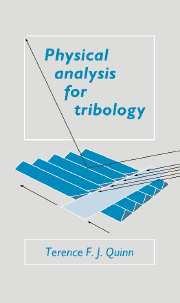Book contents
- Frontmatter
- Contents
- Preface
- Nomenclature list
- 1 Tribology
- 2 Macroscopic physical techniques
- 3 Microscopic physical techniques for studying atomic arrangement
- 4 Microscopic techniques for studying atomic structure
- 5 The analysis of lubricant films
- 6 The analysis of surface temperatures in tribo-systems
- 7 The analysis of pitting failures in tribo-systems
- 8 The analysis of oxidational wear in tribo-systems
- 9 The application of physical techniques to selected ceramic tribo-systems
- References
- Index
8 - The analysis of oxidational wear in tribo-systems
Published online by Cambridge University Press: 29 October 2009
- Frontmatter
- Contents
- Preface
- Nomenclature list
- 1 Tribology
- 2 Macroscopic physical techniques
- 3 Microscopic physical techniques for studying atomic arrangement
- 4 Microscopic techniques for studying atomic structure
- 5 The analysis of lubricant films
- 6 The analysis of surface temperatures in tribo-systems
- 7 The analysis of pitting failures in tribo-systems
- 8 The analysis of oxidational wear in tribo-systems
- 9 The application of physical techniques to selected ceramic tribo-systems
- References
- Index
Summary
Introduction
The publication of the definitive paper by Lim and Ashby (1987) was probably the most important step towards providing tribologists with an easily applied method for estimating the type of wear mechanism most likely to occur for a given set of conditions. It is clear that mild-oxidational wear and severe-oxidational wear are very widespread in the wear mechanism map for steel (see Figure 1.5). It seems that oxidational wear is one of those areas of tribological endeavour most likely to receive an increasing amount of attention, especially in view of the interest in developing tribo-systems which can function effectively (without conventional lubrication) in high temperature environments, for example the ceramic diesel engine.
We have already discussed the oxidational theory of wear in some detail (in Section 1.4.4). In Section 6.1.4, we described how heat flow analysis in conjunction with the oxidational wear theory can be used to obtain information about temperatures (Tc) occurring at the real areas of contact, the number N of asperity contacts within those real arcs of contact and the thickness ξ of the oxide film formed at the real areas of contact. In Section 6.2.3 it was shown how proportional analysis (by X-ray diffraction) of the wear debris produced in the oxidational wear of steels, led to independent estimates of the contact temperature.
- Type
- Chapter
- Information
- Physical Analysis for Tribology , pp. 399 - 431Publisher: Cambridge University PressPrint publication year: 1991
- 1
- Cited by



